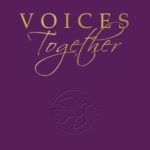This article is part of our series on Voices Together, a new worship and song collection coming fall 2020 from MennoMedia, in partnership with Mennonite Church USA and Mennonite Church Canada.
By Anneli Loepp Thiessen
Early on in the process of creating Voices Together, the Mennonite Worship and Song Committee knew that four-part traditional hymnody from Europe and European-influenced North America would be a major portion of the collection, but that attention needed to be given to additional musical styles. We decided to use and develop committee expertise on non-Western music (sometimes called “global song”) and more contemporary styles of music.
The Popular Idioms subcommittee was formed to research and assess a variety of contemporary musical forms. Our early meetings were spent trying to define what a popular idiom is, and we quickly discovered there isn’t a simple answer. We know it generally does not include traditional and contemporary hymnody, global song, short songs, and that it does include contemporary worship music, camp songs, and folk songs. But does it include gospel music? Jazz? It is a large genre that includes many styles of music, and the lines around it are not clear.
The Popular Idioms subcommittee evaluated songs from a wide range of contexts:
- Favorite songs from Mennonite camps
- Material from Anabaptist songwriters
- Contemporary worship music sung at MC USA conventions and MC Canada assemblies
- Interviews with Mennonite congregations and Voices Together surveys
- Top 100 lists from Christian Copyright Licensing International (CCLI)
- Ecumenically loved Christian folk
- Visits to Mennonite congregations in MC USA and MC Canada that worship in languages other than English
- Contemporary worship music that is loved in African American communities and Spanish speaking communities
We made sure to dedicate special attention to the following elements:
- Written by women
- Written in English and loved in multiple languages
- Written first in other languages
- Reflects the fullness of the Christian story
- Reflects various acts of worship
These sources confirmed that there is a wealth of worship music emerging from expansive, evolving contemporary idioms in recent decades. While new genres and styles will appear in Voices Together, our Mennonite hymnals have always included popular styles. Christians have often borrowed from the musical languages available to them in their surrounding cultures. An example of this is the Reformation era practice of setting new texts to popular tunes.
The 1969 Mennonite Hymnal includes a gospel section: music that embodies a sound that, at the time, was newer to many Mennonite congregations. While some people believed these songs were not appropriate for a Mennonite hymnal, the songs in this gospel section quickly became beloved. This includes anthems such as “Blessed Assurance,” “My Hope is Built on Nothing Less” and “How Great Thou Art.” These new songs were characterized by the use of refrains after each verse, something that is still found in popular idiom material. While today we likely consider these hymns to be traditional, at the time they represented a new musical idiom.
The 1992 Hymnal: A Worship Book also captured popular idioms, such as Michael W. Smith and Deborah D. Smith’s song “Great Is The Lord,” and Karen Lafferty’s “Seek Ye First.” These songs represented the contemporary worship movement, which has grown in popularity since its beginnings in the 1960s.
Voices Together will feature songs in popular idioms that are known and loved by Mennonites: contemporary gospel and folk, contemporary worship music, camp music, and jazz influences. Some music comes from previous denominational collections, some will be new to many churches, and many songs are already known and loved by Mennonites despite not being in our previous collections. Examples include “10,000 Reasons” by Jonas Myrin and Matt Redman, and “Here By the Water” by Steve Bell.
The inclusion of contemporary worship music specifically is a reflection of the church’s song: many Mennonite congregations worship in this musical idiom every week. Having this music represented in the collection will resource more congregations and allow us to better learn each other’s music. An informal survey I conducted on 78 MC Canada and MC USA congregations in the fall of 2019 indicated that 86% of them had an account with Christian Copyright Licensing International, the primary licensing company for contemporary worship music. Whether it has been acknowledged or not, contemporary worship music has become a major facet of our Mennonite worship.
Beyond music, contemporary worship styles have also influenced our worship flows and prayer structures. The Voices Together: Worship Leader Edition celebrates and supports contemporary worship, including providing leaders with guidelines on how to plan a service using a more contemporary model.
The worship resources section of Voices Together also includes words for worship that are intended to flow within a contemporary service. However, most contemporary traditions pray extemporaneously. While this is difficult to represent on a printed page, supports for strengthening spontaneous, unscripted prayer are provided.
Songs in popular idioms offer a unique gift to our collections that more traditional styles often don’t. They offer opportunities for different instrumentation: keyboards, drums, and guitars. Expansive, repetitive refrains offer an embodied, spirit-led encounter. They are best learned orally rather than from a page, using a different kind of sophisticated brain function. Although they can be led successfully by one leader, they are designed to be led by an ensemble.
The accompaniment edition for Voices Together features keyboard accompaniments that will assist congregations in implementing popular idioms if they are unfamiliar with the styles, or may provide new ideas to congregations who have long been worshipping in that way. Percussion rhythms, guitar strum patterns, and guidelines on improvising will all help worship teams and individuals lead contemporary music effectively. The pew edition of Voices Together uses chord symbols in most songs, which will make them more accessible to a wide range of instrumentalists and ensembles. The projection edition of Voices Together allows congregations to learn contemporary worship music orally, the way it is most accurately taught and authentically experienced.
Worshiping through music in popular idioms is a way to join with Mennonite congregations across Canada and the United States, Anabaptist songwriters, and Christians around the world.
Our hope is that those who hold Voices Together in their hands, whether every Sunday or at conference gatherings and events, will see themselves represented on the pages. By including popular idioms, we are empowering congregations already worshipping with contemporary styles, providing solid resources for communities that blend a range of musical idioms, and encouraging congregations unfamiliar with this music to venture towards something new.
Anneli Loepp Thiessen is an active song leader, classical musician, and music educator. She is completing her PhD in Interdisciplinary Music Research at the University of Ottawa, where she studies women in contemporary worship music. Anneli holds her Masters of Music in Piano Performance, her ARCT in Piano Performance, and a graduate diploma in Arts Management from Queens University. She is the director for Ontario Mennonite Music Camp, the co-chair of the Popular Idioms Committee for Voices Together, and the co-director of the Anabaptist Worship Network.
For more information on Voices Together, visit voicestogetherhymnal.org.
The views and opinions expressed in this blog belong to the author and are not intended to represent the views of the MC USA Executive Board or staff.



